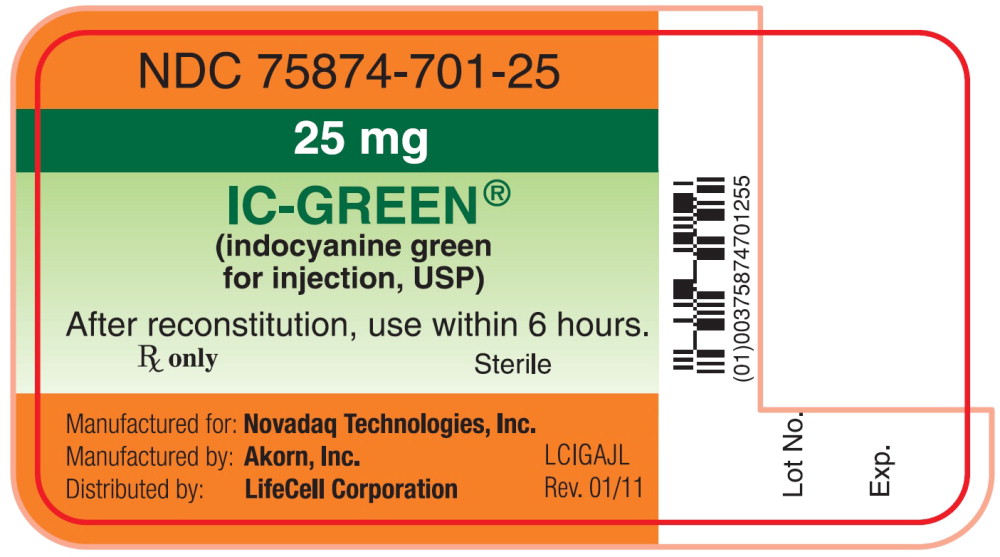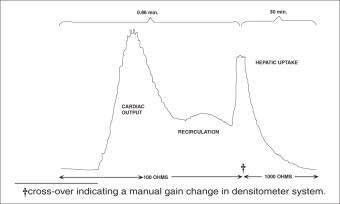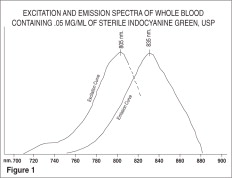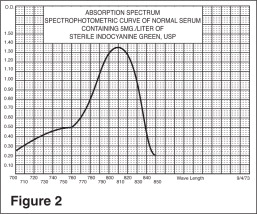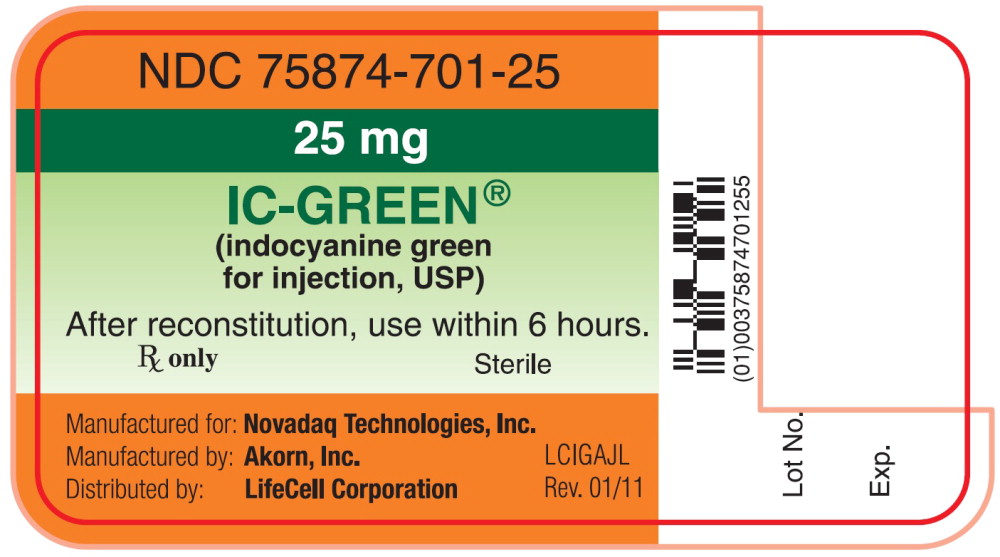Label: IC-GREEN- indocyanine green injection, powder, lyophilized, for solution
-
Contains inactivated NDC Code(s)
NDC Code(s): 75874-701-25 - Packager: Novadaq Technologies Inc.
- Category: HUMAN PRESCRIPTION DRUG LABEL
Drug Label Information
Updated August 30, 2013
If you are a healthcare professional or from the pharmaceutical industry please visit this version.
- Download DRUG LABEL INFO: PDF XML
- Official Label (Printer Friendly)
- SPL UNCLASSIFIED SECTION
-
DESCRIPTION
IC‑GREEN™ is a sterile, lyophilized green powder containing 25 mg of indocyanine green with no more than 5% sodium iodide. It is packaged with Aqueous Solvent consisting of Sterile Water for Injection used to dissolve the indocyanine green. IC‑GREEN™ is to be administered intravenously.
Indocyanine green is a water soluble, tricarbocyanine dye with a peak spectral absorption at 800 nm. The chemical name for Indocyanine Green is 1 H-Benz[e]indolium, 2-[7-[1,3-dihydro-1,1-dimethyl-3-(4-sulfobutyl)-2H-benz[e]indol-2-ylidene]-1,3,5-heptatrienyl]-1,1-dimethyl-3-(4-sulfobutyl)-,hydroxide, inner salt, sodium salt. IC‑GREEN™ has a pH of approximately 6.5 when reconstituted. Each vial of IC‑GREEN™ contains 25 mg of indocyanine green as a sterile lyophilized powder.
-
CLINICAL PHARMACOLOGY
Following intravenous injection, IC‑GREEN™ is rapidly bound to plasma protein, of which albumin is the principle carrier (95%). IC‑GREEN™ undergoes no significant extrahepatic or enterohepatic circulation; simultaneous arterial and venous blood estimations have shown negligible renal, peripheral, lung or cerebro-spinal uptake of the dye. IC‑GREEN™ is taken up from the plasma almost exclusively by the hepatic parenchymal cells and is secreted entirely into the bile. After biliary obstruction, the dye appears in the hepatic lymph, independently of the bile, suggesting that the biliary mucosa is sufficiently intact to prevent diffusion of the dye, though allowing diffusion of bilirubin. These characteristics make IC‑GREEN™ a helpful index of hepatic function.
The plasma fractional disappearance rate at the recommended 0.5 mg/kg dose has been reported to be significantly greater in women than in men, although there was no significant difference in the calculated value for clearance.
- INDICATIONS AND USAGE
- CONTRAINDICATIONS
- WARNINGS
-
PRECAUTIONS
General: IC‑GREEN™ Powder and Solution: IC‑GREEN™ is unstable in aqueous solution and must be used within 6 hours. However, the dye is stable in plasma and whole blood so that samples obtained in discontinuous sampling techniques may be read hours later. Sterile techniques should be used in handling the dye solution as well as in the performance of the dilution curves.
IC‑GREEN™ (indocyanine green for injection) powder may cling to the vial or lump together because it is freeze-dried in the vials.
Drug Interactions: Heparin preparations containing sodium bisulfite reduce the absorption peak of IC‑GREEN™ in blood and, therefore, should not be used as an anticoagulant for the collection of samples for analysis.
Drug/ Laboratory Test Interactions: Radioactive iodine uptake studies should not be performed for at least a week following the use of IC‑GREEN™.
Carcinogenesis, Mutagenesis, Impairment of Fertility: No studies have been performed to evaluate the carcinogenicity, mutagenicity, or impairment of fertility.
Pregnancy: Teratogenic Effects: Pregnanacy Category C: Animal Reproduction studies have not been conducted with IC‑GREEN™. It is also not known whether IC‑GREEN™ can cause fetal harm when administered to a pregnant woman or can affect reproduction capacity.
IC‑GREEN™ should be given to a pregnant woman only if clearly indicated.
- ADVERSE REACTIONS
- OVERDOSAGE
-
DOSAGE AND ADMINISTRATION
INDICATOR‑DILUTION STUDIES: IC‑GREEN™ permits recording of the indicator‑dilution curves for both diagnostic and research purpose independently of fluctuations in oxygen saturation. In the performance of dye dilution curves, a known amount of dye is usually injected as a single bolus as rapidly as possible via a cardiac catheter into selected sites in the vascular system. A recording instrument (oximeter or densitometer) is attached to a needle or catheter for sampling of the dye-blood mixture from a systemic arterial sampling site.
Under sterile conditions, the IC‑GREEN™ powder should be dissolved with the Aqueous Solvent provided for this product, and the solution used within 6 hours after it is prepared. If a precipitate is present, discard the solution. The amount of solvent to be used can be calculated from the dosage form which follows. It is recommended that the syringe used for injection of the dye be rinsed with this diluent. Isotonic saline should be used to flush the residual dye from the cardiac catheter into the circulation so as to avoid hemolysis. With the exception of the rinsing of the dye injection syringe, saline is used in all other parts of the catheterization procedure.
This matter of rinsing the dye syringe with distilled water may not be critical, since it is known that an amount of sodium chloride sufficient to make an isotonic solution may be added to dye that has first been dissolved in distilled water. This procedure has been used for constant-rate injection techniques without precipitation of the dye.
The usual doses of IC‑GREEN™ which have been used for dilution curves are as follows:
- Adults - 5.0 mg
- Children - 2.5 mg
- Infants - 1.25 mg
These doses of the dye are usually injected in a mL volume. An average of five dilution curves are required in the performance of a diagnostic cardiac catheterization. The total dose of dye injected should be kept below 2 mg/kg.
Calibrating Dye Curves: To quantitate the dilution curves, standard dilutions of IC‑GREEN™ in whole blood are made as follows. It is strongly recommended that the same dye that was used for the injections be used in the preparation of these standard dilutions. The most concentrated dye solution is made by accurately diluting 1 mL of the 5 mg/mL dye with 7 mL of distilled water.
This concentration is then successively halved by diluting 4 mL of the previous concentration with 4 mL of distilled water. (If a 2.5 mg/mL concentration was used for the dilution curves, 1 mL of the 2.5 mg/mL dye is added to 3 mL of distilled water to make the most concentrated "standard" solution. This concentration is then successively halved by diluting 2 mL of the previous concentration with 2 mL of distilled water.) Then 0.2 mL portions (accurately measured from a calibrated syringe) of these dye solutions are added to 5 mL aliquots of the subject's blood, giving final concentrations of the dye in blood beginning with 24.0 mg/liter, approximately (actual concentration depends on the exact volume of dye added). This concentration is, of course, successively halved in the succeeding aliquots of the subject's blood. These aliquots of blood containing known amounts of dye, as well as a blank sample of which 0.2 mL of saline containing no dye has been added, are then passed through the detecting instrument and a calibration curve is constructed from the deflections recorded.
HEPATIC FUNCTION STUDIES: Due to its absorption spectrum, changing concentrations of IC‑GREEN™ (indocyanine green for injection) in the blood can be monitored by ear densitometry or by obtaining blood specimens at timed intervals. The technique for both methods is as follows.
The patient should be studied in a fasting, basal state. The patient should be weighed and the dosage calculated on the basis of 0.5 mg/kg of body weight.
Under sterile conditions, the IC‑GREEN™ powder should be dissolved with the Aqueous Solvent provided. Exactly 5 mL of aqueous solvent should be added to the 25 mg vial giving 5 mg of dye per mL of solution.
Inject the correct amount of dye into the lumen of an arm vein as rapidly as possible, without allowing the dye to escape outside the vein. (If the photometric method is used, prior to injecting IC‑GREEN™, withdraw 6 mL of venous blood from the patient's arm for serum blank and standard curve construction, and through the same needle, inject the correct amount of dye.)
Ear Densitometry: Ear oximetry has also been used and makes it possible to monitor the appearance and disappearance of IC‑GREEN™ without the necessity of withdrawal and spectrophotometric analysis of blood samples for calibration. An ear densitometer which has a compensatory photo-electric cell to correct for changes in blood volume and hematocrit, and a detection photocell which registers levels has been described. This device permits simultaneous measurement of cardiac output, blood volume and hepatic clearance of IC‑GREEN™* and was found to provide a reliable index of plasma removal kinetics after single injections or continuous intrusions of IC‑GREEN™. This technique was employed in newborn infants, healthy adults and in children and adults with liver disease. The normal subject has a removal rate of 18‑24% per minute. Due to the absence of extra‑hepatic removal, IC‑GREEN™ was found to be ideally suited for serial study of severe chronic liver disease and to provide a stable measurement of hepatic blood flow. In larger doses, IC‑GREEN™ has proven to be particularly valuable in detecting drug‑induced alterations of hepatic function and in the detection of mild liver injury.
Using the ear densitometer, a dosage of 0.5 mg/kg in normal subjects gives the following clearance pattern.
*Dichromatic earpiece densitometer supplied by The Waters Company, Rochester, Minnesota.
Photometric
Method -
Determination Using Percentage Retention of Dye:
A typical curve obtained by plotting dye concentration versus optical density is shown opposite. Percent retention can be read from this plot.
If more accurate results are desired, a curve using the patient's blood and the vial of IC‑GREEN™ being used in the determination can be constructed as follows:
- Take 6 mL of non-dye-containing venous blood from the patient's arm. Place in a test tube and allow the blood to clot. The serum is separated by centrifugation.
- Pipette 1 mL of the serum into a microcuvette.
- Add 1 lambda (λ) of the 5 mg/mL aqueous IC‑GREEN™ (sterile indocyanine green) solution to the serum, giving a dilution of 5 mg/liter, the standard for 50% retention. (The addition of 2 lambda (λ) of the 5 mg/mL IC‑GREEN™ solution would give 100% retention; however, this concentration cannot be read on the spectrophotometer.)
- The optical density of this solution is read at 805 nm, using normal serum as the blank.
- Using graph paper similar to that used in the illustration, plot the 50% figure obtained in Step 4, and draw a line connecting this point with the zero coordinates.
Percentage Retention: A single 20‑minute sample (withdrawn from a vein in the opposite arm to that injected) is allowed to clot, centrifuged and its optical density is determined at 805 nm using the patient's normal serum as the blank. Dye concentration is read from the curve above. A single 20‑minute sample of serum in healthy subjects should contain no more than 4% of the initial concentration of the dye. The use of percentage retention is less accurate than percentage disappearance rate, but provides reproducible results. Hemolysis does not interfere with a reading.
Determination Using Disappearance Rate of Dye: To calculate the percentage disappearance rate, obtain samples at 5, 10, 15 and 20 minutes after injecting the dye. Prepare the sample as in the previous section and measure the optical densities at 805 nm, using the patient's normal serum as the blank. The IC‑GREEN™ concentration in each timed specimen can be determined by using the concentration curve illustrated. Plot values on semilogarithmic paper.
Specimens containing IC‑GREEN™ should be read at the same temperature since its optical density is influenced by temperature variations.
Normal Values: Percentage disappearance rate in healthy subjects is 18‑24% per minute. Normal biological half‑time is 2.5 ‑ 3.0 minutes.
OPHTHALMIC ANGIOGRAPHY STUDIES: The excitation and emission spectra (Figure 1) and the absorption spectra (Figure 2) of IC‑GREEN™ make it useful in ophthalmic angiography. The peak absorption and emission of IC‑GREEN™ lie in a region (800‑850 nm) where transmission of energy by the pigment epithelium is more efficient than in the region of visible light energy. IC‑GREEN™ also has the property of being nearly 98% bound to blood protein, and therefore, excessive dye extravasation does not take place in the highly fenestrated choroidal vasculature. It is, therefore, useful in both absorption and fluorescence infrared angiography of the choroidal vasculature when using appropriate filters and film in a fundus camera.
Dosages up to 40 mg IC-GREEN™ dye in 2 mL of aqueous solvent have been found to give optimal angiograms, depending on the imaging equipment and technique used. The antecubital vein injected IC-GREEN™ dye bolus should immediately be followed by a 5 mL bolus of normal saline.
Clinically, angiograms of uniformly good quality can be assured only after taking care to optimize the contributions of all possible factors such as, patient cooperation and dye injection. The foregoing injection regimen is designed to provide delivery of a spatially limited dye bolus of optimal concentration to the choroidal vasculature following intravenous injection.
- HOW SUPPLIED:
- PRINCIPAL DISPLAY PANEL
-
INGREDIENTS AND APPEARANCE
IC-GREEN
indocyanine green injection, powder, lyophilized, for solutionProduct Information Product Type HUMAN PRESCRIPTION DRUG Item Code (Source) NDC:75874-701 Route of Administration INTRAVENOUS Active Ingredient/Active Moiety Ingredient Name Basis of Strength Strength Indocyanine green (UNII: IX6J1063HV) (Indocyanine Green Acid Form - UNII:C4V974V932) Indocyanine green 25 mg Packaging # Item Code Package Description Marketing Start Date Marketing End Date 1 NDC:75874-701-25 1 in 1 VIAL, GLASS Marketing Information Marketing Category Application Number or Monograph Citation Marketing Start Date Marketing End Date NDA NDA011525 09/15/2013 Labeler - Novadaq Technologies Inc. (203343858)

